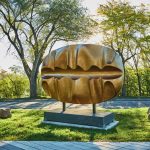

Born in Montréal, Jean Le Fébure studied at the École des beaux-arts de Montréal, then at the School of Architecture at the Université de Montréal. Between 1949 and 1952, he participated in a number of automatist exhibitions, including the Salon des Rebelles in 1950. He lived in Paris from 1953 to 1965, during which time he had exhibitions in Spain, Italy, Switzerland, and France. When he returned to Québec, he taught at the School of Architecture at Université Laval, then at the CÉGEP de Saint-Laurent. Le Fébure was known mainly as a painter, and his works are in the collections of, among others, the Musée d’art contemporain de Montréal, the Montréal Museum of Fine Art, and the National Gallery of Canada.

Artwork description
The artwork is installed in Parc Jean-Drapeau on St. Helen’s Island, in the green space nearest to the Pont du Cosmos. It is an abstract monolithic oval sculpture with an undulating surface and a hollow running horizontally across. Evoking the billboards that border highways, its mode of presentation is frontal: it is designed to be seen by both motorists and pedestrians. It is meant to appear dazzling and fleeting, in the glare of the light that it reflects, and then to quickly disappear once the edge of its space has been passed.
You have to be able to “read” it in less than a second as you’re travelling 100 miles an hour. . . . You don’t have the time to wait to understand; the message has to hit like lightning.
– Jean Le Fébure
This creation is the outcome of a long reflection on art, which Le Fébure felt should mirror the reality of the modern world. During his prolonged stay in Europe, he developed, at the nuclear research centre in Saclay, France, a new fibreglass-based material into which he integrated stone aggregates or metal with epoxy and polyesters. He made Signe solaire out of this material, to which he added bronze filings.
Le Fébure produced very few sculptures during his career, which explains the importance of Signe solaire in his body of work.



